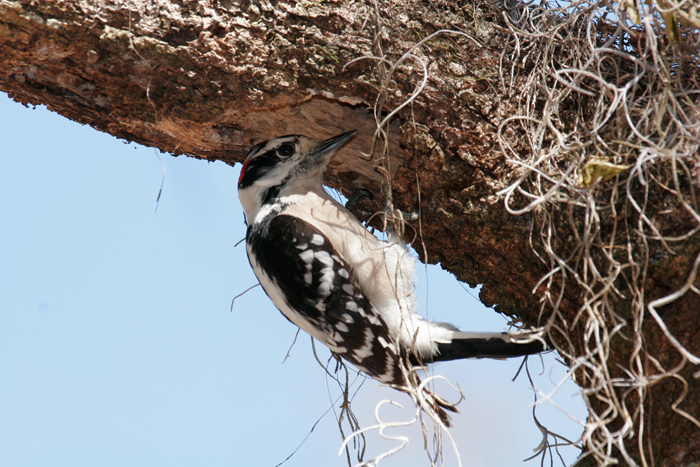
Downy Woodpecker foraging for insects on a decaying tree limb. UF/IFAS Photo: Thomas Wright
Driving through urban neighborhoods, one is hard pressed to see a dead, standing or downed tree in a yard. Called a snag, these dead trees are virtually absent in many urban neighborhoods. This absence of dead/dying trees impacts many animals because these dead/dying trees are used for shelter and foraging for many different species. Snags are habitat for a variety of beetle larvae and other insects, which are in turn food for birds such as woodpeckers. Woodpeckers are designed to find and feed on insects that are feeding on dead trees. In fact, snags are correlated to the abundance and distribution of a variety of urban woodpeckers in urban areas. Not only do woodpeckers use snags to hunt for insects, they use snags for communication. Pounding out a rhythm on a trunk or branch, these sounds are communicating that 'this is my territory!'
Further, many birds raise their offspring in the cavities or tree holes that are excavated by woodpeckers. Primary cavity-nesters, such as woodpeckers, excavate their own tree holes, usually in dead or dying trees. Secondary cavity-nesters, such as titmice, chickadees, owls, great-crested flycatchers, and others, don't make their own cavities but use cavities excavated by primary cavity-nesting birds, or they use natural cavities. Thus, retaining snags in a neighborhood benefits a wide variety of species by presenting them with foraging and nesting opportunities. If safety is a concern in leaving snags standing, then ask a tree surgeon to cut the tree to a height that will not hurt your house.
Don't have any snags? If you do not have dead tress in your yard, bird boxes could be installed on trees or posts. Also, you can create "hard" snags in your yard. This is where the top 1/3 of the tree is removed and some of the side branches; this creates ideal conditions where the inside of the tree begins to decay first. A "hard" outside with a soft inside is ideal for cavity-nesting birds. You can even "plant" a downed tree in the yard to provide a snag for species.
Spread the word in your neighborhood. Many trees are cut down without much thought to their value for wildlife. Make an effort to keep snags in your yard. Once accomplished, place signs that state "woodpecker habitat," such advertisement will entice other residents to take up the call and conserve snags.